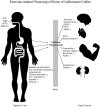International society of sports nutrition position stand: coffee and sports performance
- PMID: 37498180
- PMCID: PMC10375938
- DOI: 10.1080/15502783.2023.2237952
International society of sports nutrition position stand: coffee and sports performance
Abstract
Based on review and critical analysis of the literature regarding the contents and physiological effects of coffee related to physical and cognitive performance conducted by experts in the field and selected members of the International Society of Sports Nutrition (ISSN), the following conclusions represent the official Position of the Society:(1) Coffee is a complex matrix of hundreds of compounds. These are consumed with broad variability based upon serving size, bean type (e.g. common Arabica vs. Robusta), and brew method (water temperature, roasting method, grind size, time, and equipment).(2) Coffee's constituents, including but not limited to caffeine, have neuromuscular, antioxidant, endocrine, cognitive, and metabolic (e.g. glucose disposal and vasodilation) effects that impact exercise performance and recovery.(3) Coffee's physiologic effects are influenced by dose, timing, habituation to a small degree (to coffee or caffeine), nutrigenetics, and potentially by gut microbiota differences, sex, and training status.(4) Coffee and/or its components improve performance across a temporal range of activities from reaction time, through brief power exercises, and into the aerobic time frame in most but not all studies. These broad and varied effects have been demonstrated in men (mostly) and in women, with effects that can differ from caffeine ingestion, per se. More research is needed.(5) Optimal dosing and timing are approximately two to four cups (approximately 473-946 ml or 16-32 oz.) of typical hot-brewed or reconstituted instant coffee (depending on individual sensitivity and body size), providing a caffeine equivalent of 3-6 mg/kg (among other components such as chlorogenic acids at approximately 100-400 mg per cup) 60 min prior to exercise.(6) Coffee has a history of controversy regarding side effects but is generally considered safe and beneficial for healthy, exercising individuals in the dose range above.(7) Coffee can serve as a vehicle for other dietary supplements, and it can interact with nutrients in other foods.(8) A dearth of literature exists examining coffee-specific ergogenic and recovery effects, as well as variability in the operational definition of "coffee," making conclusions more challenging than when examining caffeine in its many other forms of delivery (capsules, energy drinks, "pre-workout" powders, gum, etc.).
Keywords: Coffee; bioactives; caffeine; chlorogenic acids; ergogenic; polyphenols.
Conflict of interest statement
LML is President of Nutrition, Exercise, and Wellness Associates, which receives financial support from educational, food and/or dietary supplement companies that produce, market, distribute, or sell coffee-related products. He has received sports nutrition-related grants, as well as financial compensation for speaking at conferences and writing lay articles about sports nutrition; DA reports no conflicts of interest; KFS reports no conflicts of interest;
AS reports no conflicts of interest; GE has no current conflicts of interest specifically related to coffee, but he previously received funding for research on Bang Keto-Coffee. He has received other funding from dietary supplement companies for research, honoraria for speaking at conferences/writing lay articles, consulting in industry, and as an expert witness on dietary supplements; SCC reports no conflicts of interest; CMK has consulted with and received external funding from companies who sell certain dietary ingredients and have received remuneration from companies for delivering scientific presentations at conferences. He also writes for online and other media outlets on topics related to exercise and nutrition;
MTN has no conflict in terms of financial or business interests related to the topic of this manuscript. He has served as a paid consultant for industry; has received honoraria for writing lay articles and other media about sports nutrition/exercise performance; TNZ has no conflict in terms of financial or business interests related to the topic of this manuscript. He has received grants and contracts to conduct research on dietary supplements; has served as a paid consultant for industry; has received honoraria for speaking at conferences and writing lay articles about sports nutrition ingredients; receives royalties from the sale of several sports nutrition products (but not coffee compounds); and has served as an expert witness on behalf of the plaintiff and defense in cases involving dietary supplements;
TAV has no current conflicts of interest specifically related to coffee. She has received other funding from dietary supplement companies for research, honoraria for speaking at conferences/writing lay articles, and consulting in industry; DK reports that he has no conflicts of interest to report. DK has in the past conducted sponsored research with dietary ingredients, foods, and beverages, including caffeine; BC has no conflict in terms of financial or business interests related to this manuscript. BC has received grants and contracts to conduct research on dietary supplements; has served as a paid consultant for industry; has received honoraria for speaking at conferences and writing lay articles about sports nutrition ingredients and topics; and has served as an expert witness on behalf of the plaintiff and defense in cases involving dietary supplements; R.B.K. has conducted funded research on nutritional supplements through grants and contracts awarded to the universities he has been affiliated, received an honorarium for making scientific presentations about dietary supplements, served as an expert on legal cases involving dietary supplements, and consulted with industry on product development, including caffeine-containing supplements. He has no direct financial conflict of interest with the publication of this paper; JA reports no conflicts of interest.
Figures


References
MeSH terms
Substances
LinkOut - more resources
Full Text Sources
